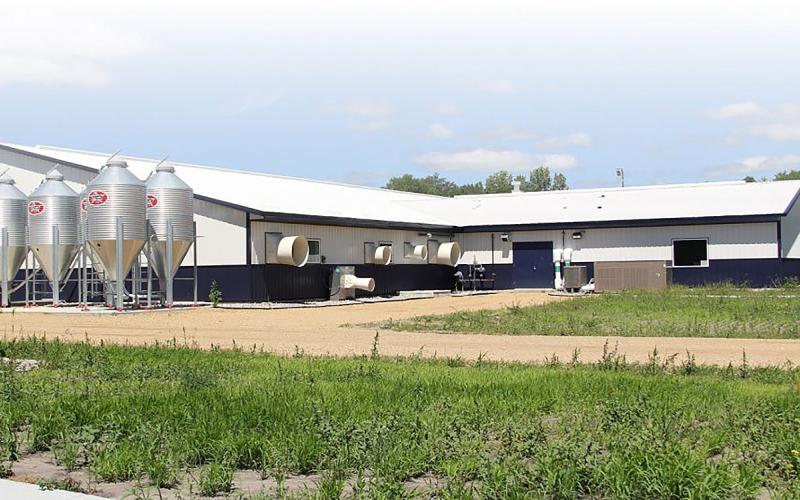
Written with contributions by Adele Harty, former SDSU Extension Cow/Calf Field Specialist.
Wet conditions that hamper fall harvest can result in corn still remaining in fields into the spring. Removal of that crop from fields may be challenging in springtime weather, but important, as illustrated in in our article, Standing Corn Considerations.
Getting corn harvested from such fields is just the first challenge, however. The quality of the harvested grain may severely limit its marketability and usefulness. Moldy grain is the main consideration. Moisture content is another.
Testing Feed for Mold Counts
While livestock producers know that moldy grain and forage are not ideal feedstuffs, they also know that stored feed occasionally contains a small amount of visible mold, and that their animals consume it with no obvious adverse effects. The question arises, how much mold is too much for a feed to be unsuitable for animals? Also, which type of molds pose the most concern for aflatoxin and mycotoxin production?
Labs that test feedstuffs for mold report their results in terms of cfus/gram (“spore count”). In general, feedstuffs with spore counts of 1 million or less per gram are safe to feed to livestock. Adjustments in rations should be made when feeds with higher spore counts are fed. Table 1 indicates safety levels and feeding risks and concerns.
| Cfu/gram | Feeding Risk and Concerns 1 |
| Under 500,000 | Relatively low count |
| 500,000 to 1 million | Relatively safe |
| 1 to 2 million | Discount energy (x 0.95) feed with caution |
| 2 to 3 million | Closely observe animals and performance, discount energy (x 0.95) |
| 3 to 5 million | Dilute with other feeds, discount energy (x 0.95), observe closely |
| Over 5 million | Discontinue feeding |
1 Risks refer primarily to effects of mold per se without regard to possible mycotoxin content. Depressed digestibility, feed intakes, and performance may
occur from a high mold content without mycotoxins present. Harmful mycotoxins may be present, even when there is little or no obvious mold content.
As seen from Table 1, adjustments need to be made to rations due to mold counts in the feeds. Accumulation of mold can reduce the digestibility of the diet by up to 5% in ruminants, which is why Table 1 shows a 5% discount in energy levels once the mold counts reach 1 million. In addition to the reduced digestibility, palatability is another concern. Observing a reduction in feed intake of moldy feeds would not be unexpected, so diluting these feeds to reduce palatability concerns can result in more-consistent intake. If mold counts reach 3 to 5 million, the feed should be diluted to 50% or less of the total ration and mixed with other feeds that contain few to no mold spores.
Grain tested for marketing purposes will sometimes have mold results reported as % mold damage. This is an estimate of the number of moldy kernels in a sample and is difficult to interpret regarding suitability for livestock feed.
Mycotoxin Considerations
For livestock feeding purposes, knowing whether mycotoxins are present in moldy feed is much more important than knowing mold spore counts. Mycotoxins are chemicals produced by certain molds; they adversely affect the health and production of animals exposed to them, and their presence may make their products (particularly milk) unsalable. Not all molds produce mycotoxins, and important levels of mycotoxins can be present when mold infestation appears mild.
Mycotoxins important in livestock feeding include vomitoxin (DON), fumonisin, zearalenone, T-2, and aflatoxin. Their effects on animals depend on the individual toxin and the amount consumed, and they can include feed refusal, decreased growth and milk production, reproductive problems, and – in the case of aflatoxin – death losses. The effects of mycotoxins can appear vague, lag behind feeding substantially, and are difficult or impossible to detect in the body – making their detection in feedstuffs prior to their use very important.
Knowing the specific mycotoxins and their concentrations present in feed can help inform how the feed might be used for animal feed. Different animal species and production stages have different sensitivities to mycotoxins – examples of which are found in the article, Mold and Mycotoxin Problems in Livestock Feeding, courtesy of PennState Extension. In general, feedlot calves are less likely to experience adverse effects of mycotoxins compared to breeding-age cows, pigs, poultry, or dairy cows.
Sampling and Testing Feed
Moldy feeds should be sampled prior to use and screened for the presence of mycotoxins. The NDSU Veterinary Diagnostic Laboratory runs an extensive mycotoxin screening panel. Producers should remember that unless the sampled grain is dry (< 15% moisture), mold growth and mycotoxin production will likely increase as the grain is stored. As with any feed evaluation, representative sampling technique is critical. A sample analysis is only as good as the sample the screen was completed on. A representative sample of the feedstuff will ensure that the sample sent to the lab represents the total of the feed available to be fed. There are suggested sampling methods outlined depending on the moisture content of the sample. These methods will help ensure a representative sample, as discussed on PennState Univeristy Extension's website. Their website also provides valuable information on interpreting results.
Reference
- Mold and Mycotoxin Problems in Livestock Feeding, PennState University Extension.
